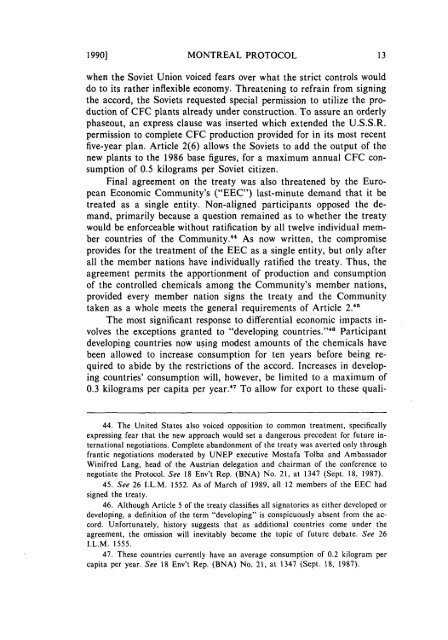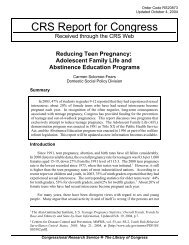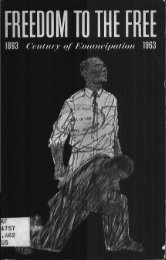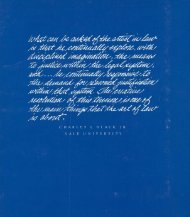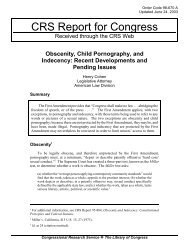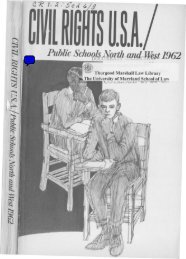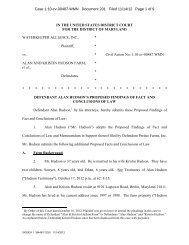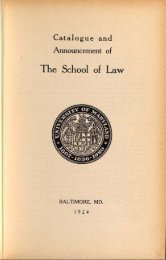journal - University of Maryland School of Law
journal - University of Maryland School of Law
journal - University of Maryland School of Law
Create successful ePaper yourself
Turn your PDF publications into a flip-book with our unique Google optimized e-Paper software.
1990]<br />
MONTREAL PROTOCOL<br />
when the Soviet Union voiced fears over what the strict controls would<br />
do to its rather inflexible economy. Threatening to refrain from signing<br />
the accord, the Soviets requested special permission to utilize the production<br />
<strong>of</strong> CFC plants already under construction. To assure an orderly<br />
phaseout, an express clause was inserted which extended the U.S.S.R.<br />
permission to complete CFC production provided for in its most recent<br />
five-year plan. Article 2(6) allows the Soviets to add the output <strong>of</strong> the<br />
new plants to the 1986 base figures, for a maximum annual CFC consumption<br />
<strong>of</strong> 0.5 kilograms per Soviet citizen.<br />
Final agreement on the treaty was also threatened by the European<br />
Economic Community's ("EEC") last-minute demand that it be<br />
treated as a single entity. Non-aligned participants opposed the demand,<br />
primarily because a question remained as to whether the treaty<br />
would be enforceable without ratification by all twelve individual member<br />
countries <strong>of</strong> the Community." As now written, the compromise<br />
provides for the treatment <strong>of</strong> the EEC as a single entity, but only after<br />
all the member nations have individually ratified the treaty. Thus, the<br />
agreement permits the apportionment <strong>of</strong> production and consumption<br />
<strong>of</strong> the controlled chemicals among the Community's member nations,<br />
provided every member nation signs the treaty and the Community<br />
taken as a whole meets the general requirements <strong>of</strong> Article 2.'<br />
The most significant response to differential economic impacts involves<br />
the exceptions granted to "developing countries." 4 Participant<br />
developing countries now using modest amounts <strong>of</strong> the chemicals have<br />
been allowed to increase consumption for ten years before being required<br />
to abide by the restrictions <strong>of</strong> the accord. Increases in developing<br />
countries' consumption will, however, be limited to a maximum <strong>of</strong><br />
0.3 kilograms per capita per year. 47 To allow for export to these quali-<br />
44. The United States also voiced opposition to common treatment, specifically<br />
expressing fear that the new approach would set a dangerous precedent for future international<br />
negotiations. Complete abandonment <strong>of</strong> the treaty was averted only through<br />
frantic negotiations moderated by UNEP executive Mostafa Tolba and Ambassador<br />
Winifred Lang, head <strong>of</strong> the Austrian delegation and chairman <strong>of</strong> the conference to<br />
negotiate the Protocol. See 18 Env't Rep. (BNA) No. 21, at 1347 (Sept. 18, 1987).<br />
45. See 26 I.L.M. 1552. As <strong>of</strong> March <strong>of</strong> 1989, all 12 members <strong>of</strong> the EEC had<br />
signed the treaty.<br />
46. Although Article 5 <strong>of</strong> the treaty classifies all signatories as either developed or<br />
developing, a definition <strong>of</strong> the term "developing" is conspicuously absent from the accord.<br />
Unfortunately, history suggests that as additional countries come under the<br />
agreement, the omission will inevitably become the topic <strong>of</strong> future debate. See 26<br />
I.L.M. 1555.<br />
47. These countries currently have an average consumption <strong>of</strong> 0.2 kilogram per<br />
capita per year. See 18 Env't Rep. (BNA) No. 21, at 1347 (Sept. 18, 1987).


